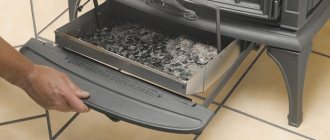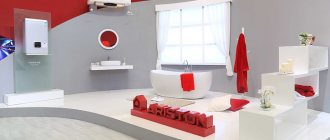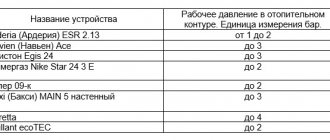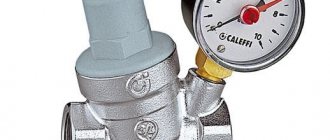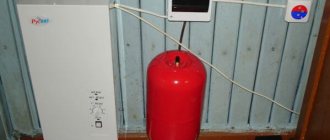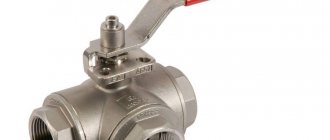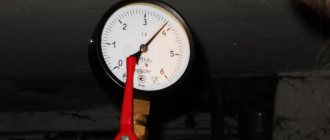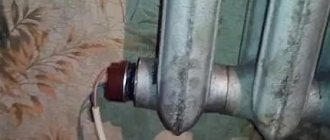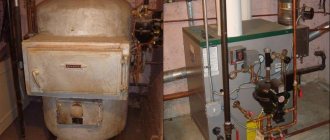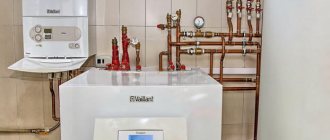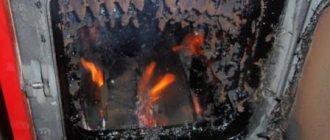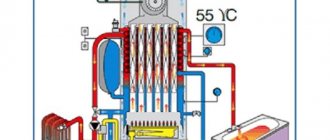The key factor influencing the efficiency of the boiler is the draft in the flue duct. When it increases, for solid fuel boilers, the combustion of coal or firewood improves, which increases the efficiency of the installation. For gas boilers, the draft must be strictly stabilized to ensure normal combustion and not blow out the flame. When constructing a chimney, especially when it is not possible to use the most optimal route, it becomes necessary to use a chimney draft amplifier. What can affect cravings and how to implement this, we will consider further.
Installing a solid, liquid or gaseous fuel boiler, stove or fireplace necessarily involves installing a chimney exhaust system. The main parameters of the chimney are the draft level and the volume of exhaust gases. Structurally, it is an insulated channel, a pipe laid from the exit of the firebox to the external environment outside the building. The draft is created due to the difference in pressure at the chimney inlet and outlet, which is caused by the temperature difference and the difference in levels between the inlet and outlet. The higher the chimney, the stronger the draft. The thicker the channel, the greater the volume of gases it can remove from the boiler.
However, there are a number of reasons why the draft in the chimney may decrease, or even “overturn” when air is sucked from outside into the chimney and combustion products enter directly into the room.
Causes of poor traction
Conventionally, two large groups can be distinguished: the design features of the chimney and external factors that affect the level of draft.
Design features include such points as:
- Using elbows and tees along the chimney, avoiding obstacles that create aerodynamic resistance.
- Using the wrong chimney section and height, different from the boiler manufacturer's requirements.
- Incorrect installation of the gate (damper) and its adjustment
- Availability of chimney head, umbrellas, spark arrester, etc.
External factors mean:
- The location of the chimney outlet is below the roof ridge, which, in a certain wind direction, can cause the draft to “overturn.”
- The presence of large objects near a chimney, a neighboring building or other structure that creates a vacuum zone or, conversely, increased pressure in the chimney area.
- The predominance of strong winds or, conversely, the dominance of calm weather.
All of this affects the level of traction, often creating additional resistance and reducing it. In any case, it will be necessary to find an adequate way to increase the draft or stabilize it in order to ensure the most efficient operation of the boiler or furnace.
Types of deflectors
There are several types of deflectors. They differ from each other in shape and number of parts. At the same time, you can choose the materials that are used to create them to your taste. It could be:
- Copper
- Cink Steel
- Stainless steel
Their shape can be very diverse: from cylindrical to round. The upper part of the deflector structure may have a cone-shaped umbrella or a gable roof. The device can also be equipped with various decorative elements, for example, a weather vane.
Let's take a closer look at several varieties:
TsAGI deflector
A structure whose parts are connected by flange or other means. This device is made from stainless steel, less often from galvanized steel. Its feature is its cylindrical shape.
Round volper
Its shape resembles the TsAGI deflector, but its main difference is the upper part. This device is most often installed on chimneys in small extensions, for example, in bathhouses.
Grigorovich deflector
If the site is located in an area with low winds, then such a device will provide excellent traction for many years. Experts call it a modified version of the TsAGI deflector.
Disc Astato
This type of device is distinguished by its simplicity and efficiency. This open-type deflector is made of galvanized or stainless steel, which improves traction efficiency in any wind direction.
H-shaped deflector
Its design is particularly reliable, since the deflector is made of stainless steel, and all parts are connected using the flange method. It can be installed in areas with any wind direction.
Weather vane deflector
This version of the device is the most popular and widespread. It has a rotating body on which a small weather vane is attached. The construction is made from stainless steel.
Rotating deflector
This device allows for maximum protection of the channel from clogging with debris and precipitation. Rotation occurs in one direction only. It is worth noting that it is necessary to monitor its condition, since in case of icing, as well as in calm conditions, the deflector will not work. Therefore, many people install it on gas boilers. It is also used as a rotary turbine, which is necessary for ventilation of residential and office spaces.
In addition, there is a Khanzhonkov deflector. However, it is currently not used, since more modified models of devices can be found on the market.
Methods and devices
During normal operation of the chimney, the pressure of the upward flow should be in the range of 10-20 Pa, which corresponds to the optimal flow of exhaust gases from the combustion chamber. To find out the real state of affairs, anemometers are used that can show the level of draft. Based on the instrument readings and the result of fuel burning, you can accurately say whether it is necessary to increase or decrease thrust, or use stabilizers that will automatically maintain the ideal air flow rate in the channel.
There are many ways to increase draft or bring it into compliance with the standards and requirements of the boiler manufacturer:
- Increasing the height of the chimney;
- The use of deflectors, weather vanes, rotary turbines as a chimney head;
- The use of smoke exhausters powered by electricity;
- Traction stabilizers.
Methods for checking draft in the chimney duct
Traditionally, before the start of the heating season, and simply before lighting the stove, many stove makers advise checking the draft in the chimney. This procedure allows you to check not only the draft force, but also determine the condition of the chimney, the possibility of using a direct channel (it is also called the “summer passage” because it was used mainly in the summer, when the furnace is fired mainly for cooking, and not for heating the room) and chimney ducts intended for heating the room.
The test method used is burning a sheet of newspaper. If the smoke from the newspaper quickly goes into the channel and does not show signs of backdraft, then we can assume that the chimney channel is clean and ready for use. You can reliably verify that the smoke has come out of the pipe head by burning rotten wood or coniferous wood.
Another way to determine the direction of air movement is to check the deflection of the flame of a candle lit at the blower. If it visibly deviates towards the blower, it means that the draft in the chimney is satisfactory. Well, if the flame stands still without deviation or deviates in the other direction, then this is a specific signal that urgent measures need to be taken to increase the draft in the furnace.
Increasing the chimney height
The simplest and most often reliable way to cope with a low draft level is to increase the height of the chimney. As a result of an increase in the level difference between the boiler and the chimney outlet, the pressure difference also increases, the upward flow of hot gases significantly increases the draft. The optimal height of the chimney is 5-6 meters, provided there is a minimum distance between the boiler and the vertical part of the channel and the absence of various deviations, bends and thinning of the channel.
Calculation of the height of the chimney, depending on the location from the roof ridge
In the case of various external factors, such as a high roof profile, ridge, nearby buildings or other objects that worsen the situation, this gives a better result. However, if the chimney is too high, the draft can significantly exceed the required threshold, causing most of the heat to simply go outside, heating the environment, and not the working fluid in the heating system. The fuel will burn worse. To prevent this effect, dampers or draft stabilizers are used, which can be used to reduce the volume of exhaust gases.
Eight ways to increase efficiency
The efficiency of a wood-burning stove varies between 60-80%. It all depends on its design, the length of the chimney, the materials used for its construction and the firewood used. The efficiency increases significantly when using birch and oak logs with a humidity level of 13-15%. The higher the humidity, the less heat transfer and the more resin will remain on the internal surfaces.
You can increase the heat transfer of a potbelly stove and increase the efficiency indicator in the following ways - here is a list of them:
- Providing pyrolysis combustion of wood - it increases efficiency by 5-10%.
- Creating smoke circulation – the main task here is to maximize heat extraction from combustion products.
- Creating a natural convection system will improve the airflow of the potbelly stove, increasing heat transfer and accelerating the heating of the room.
- Fan blowing - as in the case of natural convection.
- Lining the potbelly stove with bricks retains heat and stabilizes the temperature.
- Increasing heat transfer through an air heat exchanger is a complex but very effective method.
- Increasing the length of the chimney is important if there is free space in the room.
We invite you to familiarize yourself with the Deflector on the pipe to increase traction
Let's look at each method in more detail. All the modifications presented in the review can be done using the example of a simple rectangular potbelly stove.
It is quite easy to increase the efficiency of a potbelly stove - you just need to improve the heat extraction. In traditional stoves, it instantly evaporates into the chimney. As a result, the efficiency remains low, and the stove “heats the street.” In other words, you literally throw away about 30-40% of the wood, it goes to waste. The problem is solved in a simple way - you need to retain the heat inside the potbelly stove for as long as possible. For this purpose, two smoke circulations are organized in it. They allow you to increase resistance, causing heat to escape into the walls.
This problem is best solved at the initial stage of assembling the potbelly stove. Weld two pieces of sheet iron into it, as indicated in the drawing. They form two smoke circuits. Passing through them, combustion products will give off heat to the maximum. And only after that they will go up the chimney.
Scheme of a stove-stove.
Pyrolysis combustion
Combustion products are full of heat and contain flammable elements. Afterburning them with secondary air allows you to extract additional kilocalories. To achieve this, wood is burned with limited supply of primary air. The next task is to burn out what is contained in the combustion products. Pyrolysis gases burn releasing a large amount of thermal energy. It is absorbed and emitted by the metal walls of the potbelly stove. Due to this, we will be able to increase its efficiency.
To organize pyrolysis combustion, you will need smoke circulation from the previous section. At the level of the first turn, the supply tube is welded. Secondary air is supplied through it. In its presence, the pyrolysis products are burned out - the efficiency increases by 5-10% of the initial value. On a monthly basis, this will result in savings of several tens of kilograms of firewood. Be sure to provide for the supply of “secondary” if you have already made smoke circulation.
Increasing the efficiency of a potbelly stove with your own hands involves creating a convector. Natural convection improves heat removal and ensures quick heating of the room. By installing a stove with a convector in the garage, we will get an excellent heating device. Literally 15-20 minutes after ignition, a comfortable temperature will be established in the garage. Our task is the following - we need to create a convector that sucks in air from below and exhausts it from above.
The easiest way to increase efficiency is to equip your potbelly stove with a metal screen. It is a sheet of iron that wraps the stove on the sides and back like a shirt. The distance between the body and the sheet is from 3 to 5 cm. The sheet is welded onto metal spacers - make them from thin reinforcement.
Fins will help increase the efficiency of a potbelly stove. It can be done:
- From a profile rectangular pipe 20x40 mm.
- Made from a U-shaped metal profile.
- From a traditional round inch pipe.
We scald the back and side walls with the selected material. This will help increase the dispersion area. At the same time, we will get an effective convector.
Forced convection is more effective than natural convection. And it’s not so much a matter of efficiency, but rather the speed of heating the room. For these purposes, you need to use any fan – even a household one. We place it 50-60 cm from the stove, connect it to the power supply, turn it on and enjoy the result. A powerful air flow will effectively remove heat from the surface of the stove and distribute it throughout the room. The costs are minimal - you only need an old fan with a low noise level so that it does not put pressure on your ears.
Quite an interesting way to significantly increase the efficiency of a traditional potbelly stove. To do this, we take the following steps:
- Take a small old gas cylinder or other metal container.
- We weld metal tubes between the bottom and the lid.
- We make cutouts in the side walls to suit the diameter of the chimney.
- We cut the chimney and weld the resulting module into it.
Such a non-trivial solution will significantly increase the efficiency of your potbelly stove.
The result should be a design like the one in the picture below. Next, all that remains is to install a fan opposite the module, blowing air through the tubes. This step will help increase efficiency by removing the heat remaining in the combustion products.
In other words, our task is to cool the combustion products as much as possible, removing all remaining thermal energy from them.
It cannot be said that this method allows you to radically increase the efficiency of a metal potbelly stove. It provides:
- Maintaining temperature when the flame goes out.
- Safety of using the stove.
- Creation of natural convection.
- More uniform heat transfer.
Increased efficiency can be achieved in other ways. As for the brickwork, which follows the contours of the rear and side walls, it only complements other technical solutions.
We suggest you familiarize yourself with the reasons for no draft in the fireplace
Increased efficiency is achieved by increasing the total length of the chimney. Moreover, it is not the vertical part that increases, but the horizontal one. The bottom line is that combustion products will heat the metal of the chimney, which is why most of the heat will be retained indoors. The gases at the outlet of the chimney will become much colder.
When increasing the length of the chimney pipe, it is necessary to place the potbelly stove at one end of the room, and place the chimney itself at the other end. The horizontal section of the pipe will connect the chimney to the stove and ensure efficient heat removal.
An additional way to increase efficiency is to retrofit the chimney with convection pipes. This step will increase the heat transfer area and create additional convection.
This step will increase efficiency by 1-2%. We will not touch the stove itself, but will cover the corner in which the potbelly stove is installed with galvanized iron. Thus, we will prevent some of the heat from escaping into the walls, directing it into the heated room. Fireproof thermal insulation can be laid between the iron sheet and the wall.
In order to solve the problem with cravings once and for all, it is worth approaching the problem in a comprehensive manner. Here it is worth thinking about how to increase the draft in the furnace not only using traditional methods, but also using additional equipment.
First way
The first and most effective method of increasing draft in houses with brick chimney ducts is to clean the smoke ducts. This entertainment is not the most pleasant, but perhaps one of the simplest and most necessary. Anyone who is not afraid of heights and soot can increase traction with their own hands using a metal brush, cable and weight.
Second way
The second point is the installation of a deflector on the head of the pipe. This device has several types of design. Most parts can be cut from roofing or galvanized iron and connected using aluminum rivets. Such a device will not easily increase thrust; it will ensure its constantly high value in any weather.
Third way
Another method to quickly and effectively create good draft is the ability to install a smoke vane on the head of the pipe. This method is especially useful in cases where the chimney is not installed correctly on the roof or has significant flaws. The essence of this device is that with the help of a weather vane and metal protective plates mounted on a bearing, smoke is removed from the chimney regardless of the strength of the wind.
Deflectors
Special devices attached to the chimney head. Their shape and design are selected so that the air flows directly near the chimney outlet do not interfere with the exit of gases, but, on the contrary, contribute to this. The action of the deflector is based on Bernoulli's law. If there are air currents, they flow around the main part of the deflector and create a vacuum in the area directly above the chimney exit. An excellent option for use in conjunction with solid fuel boilers, where increased draft ensures proper burning of coal and briquettes.
The deflector cannot be installed with gas boilers. Strong wind can significantly increase draft, as a result of which the burner flame can simply go out.
The effectiveness of deflectors directly depends on the presence of wind, so they are virtually useless in calm conditions and even create additional resistance.
Deflectors for hoods
This is a fairly common option for forced ventilation. A deflector is an aerodynamic device that is installed above the chimney. It increases draft in the chimney due to changes in air flow. The essence of its work is the pressure drop when air flows around an obstacle, as well as the principle of changing air flows. It turns out that its shape allows you to increase draft in the chimney. Made of stainless steel, they are not afraid of corrosion, resistant to acids and high temperatures.
It cannot be called a full-fledged fan, since the deflector has a simple shape, without working mechanisms. But, there are types of smoke deflectors designed specifically for chimneys.
- Wolpert deflector.
- Grigorovich deflector.
- Round or spherical deflector.
In addition, weather vanes, umbrellas and similar structures are often installed on chimney pipes. But they can't do everything that a high-temperature chimney fan can do. Let's look at how they work and what makes them special.
Vane
Another means of increasing draft without increasing the height of the chimney and also depending on the wind. However, unlike a deflector, a weather vane does not actually create resistance in calm weather. Its design is extremely simple. A small wing is attached to the chimney outlet, covering the head from the wind on one side.
With the help of an additional blade and its location on the other side of the chimney axis from the weather vane mount, it is always turned so as to close the mouth from air flows. They flow around it and create a vacuum at the outlet, increasing thrust.
Reviews from owners of this device indicate its unsuitability due to jamming of the rotating part by smoke deposits or freezing of precipitation.
Making a deflector with your own hands
The sizes of the deflectors are different chimney pipes.
The walls of the upper cylinder take the wind pressure and direct the air around; smoke suction is achieved by sliding along the inner surface of individual jets. The deflector cannot be classified as a fan, since the device has a simple shape and does not have working mechanisms.
The contours of the parts that were calculated and plotted on the drawing are drawn on the cardboard and cut out. Using patterns, parts are transferred to metal with the addition of 1.5 - 2 cm along the edges of the lines for ease of assembly. Structural elements are obtained in expanded form after cutting with metal scissors.
A hacksaw is used to cut strips of metal or corners to connect parts into a finished product. The prepared parts are bent and rolled in accordance with the drawing. During assembly, the elements are superimposed on each other and connected with rivets.
Required Tools
During production, materials and tools are used that do not require professional skills from the master:
- rubber or wooden mallet;
- scissors and hacksaw for metal;
- ruler, tape measure;
- chalk for drawing lines on the metal surface;
- electric drill, rivet gun;
- metal drills;
- pencil and regular scissors.
The material is thin galvanized steel, a metal strip or a small section corner. The size of the rivets is selected in accordance with the diameter of the drill. Nuts and bolts are used for installation on the pipe.
Size calculation
A drawing is made on paper, which indicates the key dimensions for creating a pattern for a weather vane-draft amplifier for the chimney.
Ratio when calculating sizes:
- the deflector height is 1.7 d;
- the width of the cap is assumed to be 2 d;
- The diffuser width is taken to be 1.3 d.
The symbol d indicates the diameter of the chimney (internal). A different size ratio will result in poor efficiency.
Rotary turbines
A special design consisting of rounded blades located at a certain angle to the axis of rotation. The turbine, under the influence of exhaust gases and external flows, always rotates in the same direction, maintaining and increasing thrust. The advantages and disadvantages are the same as for deflectors.
Electric smoke exhausters
In some situations, for example, for use with wood-burning stoves or fireplaces, it is possible to install special electric duct exhaust fans. They are designed to operate in environments with elevated temperatures and the presence of ash, condensate and other combustion products. However, it is unacceptable to install them on the chimney of a boiler operating on solid fuel; the temperature of the gases in it can reach 650-800°C.
Such smoke exhausters are capable of automating the operation of the chimney. A special temperature and flow sensor regulate the activity of the electric drive, thereby always maintaining optimal traction in the system.
What are the dangers of unregulated chimney draft?
Most often, natural draft is used to remove combustion products from a boiler, stove or fireplace. It depends on the height and cross-section of the chimney, and the boiler passport indicates the minimum permissible dimensions. Experts usually advise making the channel a little wider than that recommended by the heating installation manufacturer, and there are several reasons for this:
- as the system operates, soot will inevitably accumulate on the internal walls of the chimney, which will narrow the passage;
- when weather conditions change, natural draft changes, causing the calculated data to become irrelevant;
- if the boiler is gas, then a sharp drop in draft can lead to flame extinction, which, in the absence of appropriate sensors, will lead to a gas leak in the boiler room.
On the other hand, excess traction also has a number of undesirable consequences:
- leads to excessive fuel consumption, which is especially noticeable in solid fuel boilers and stoves;
- warm air from the combustion chamber goes too actively into the chimney instead of heating the heat exchanger;
- too much flame in the firebox leads to premature wear of the boiler, and if the walls of the combustion chamber are cast iron, then to their deformation.
In solid fuel boilers, problems with draft are much more noticeable, since at different stages of the installation the air temperature in the furnace is very different. When igniting, increased draft is required. When wood, coal or pellets flare up, the draft must be reduced, otherwise the system will be ineffective or the house will become too hot, unless there is a three-way valve at the outlet of the heat accumulator. At the stage of burning out the contents of the firebox, in order to maintain a stable temperature of water or other liquid in the system, it is necessary to increase the draft again. It becomes obvious that without a chimney draft regulator, a solid fuel boiler, like no other model, can function normally. And gas boilers when used in this way become simply explosive.
Traction stabilizers
A whole class of devices for automatic regulation of gas pressure. They are primarily designed to work in systems with known good or increased traction. Their task is to regulate the volume of exhaust gases depending on the efficiency of the main chimney. In fact, they replace ineffective dampers that constantly require attention and manual adjustment.
The principle of operation of stabilizers is based on mixing cold air from the room into the gases leaving the furnace. This allows you to reduce the temperature of the total mixture, which enters the vertical channel and reduces the flow rate.
Structurally, this can be a device assembled on the basis of a chimney tee, which has an intake valve on the branch. The movable curtain, mounted on a free axis, opens only when the pressure in the system is exceeded, which is regulated using a counterweight.
How to determine the best option
The choice of a specific solution depends on the structural features of the chimney in each individual case. The use of elements such as deflectors, weather vanes, turbines or smoke exhausters is only relevant in the presence of certain factors, such as windy weather or the impossibility of arranging a full height chimney.
The best solution remains, as always, to increase the height of the chimney and use various stabilizers, which, in combination with increased draft, can ensure optimal operation of the boiler. In this case, the influence of external factors is reduced and all possible obstacles to the creation of a natural flow of combustion products are eliminated.
